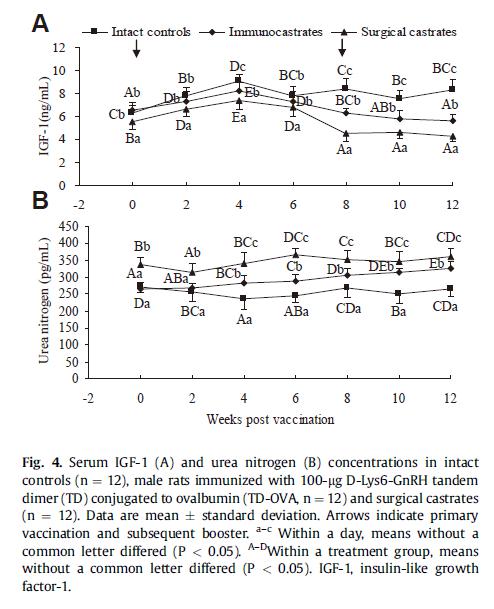Xingfa Han, Junli Li, Xiaohan Cao, Xiaogang Du, Fengyan Meng, Xianyin Zeng*. Surgical castration but not immuncastration is associated with reduced hypothalamic GnIH and GHRH/GH/IGF-I axis function in male rats[J]. Theriogenology, 2016, 86(2):657.
Abstract
Gonadotropin-inhibitory hormone (GnIH) is a potent positive regulator of the growth axis. The present study was aimed to comparatively investigate the effects of surgical and immunologic castration on hypothalamic GnIH expression and endocrine function of the growth axis. Thirty-six prepubertal male rats were randomly allocated into three groups (n=12): control, surgically castrated or immunized against 100-mg D-Lys6-GnRH-tandem peptide conjugated to ovalbumin in Specol adjuvant at 6 weeks of age (with a booster 8 weeks later). Blood samples were collected (for hormone and urea nitrogen concentrations) at 2-week intervals, and growth performance was evaluated. Compared to intact controls, surgical castration reduced (P < 0.05) messenger rna (mrna) expressions of hypothalamic gnih and growth hormone–releasing hormone (GHRH), pituitary growth hormone (GH), and liver insulin-like growth factor-1 (IGF-1), reduced (P < 0.05) serum concentrations of gh and igf-1 and increased (p < 0.05) serum concentrations of urea nitrogen. in contrast, immunocastration did not alter messenger rna expressions of hypothalamic gnih, ghrh and pituitary gh, and the serum concentrations of gh (p> 0.05). Moreover, serum concentrations of IGF-1 and urea nitrogen in immunocastrates were substantially higher and lower than those in surgical castrates, respectively (P< 0.05). compared to surgical castrates, immuncastrates had superior feed conversion efficiency and faster daily weight gain (p < 0.05). we concluded that surgical castration but not immunocastration is associated with reduced hypothalamic gnih and ghrh/gh/igf-i axis function in male rats.
